Menu
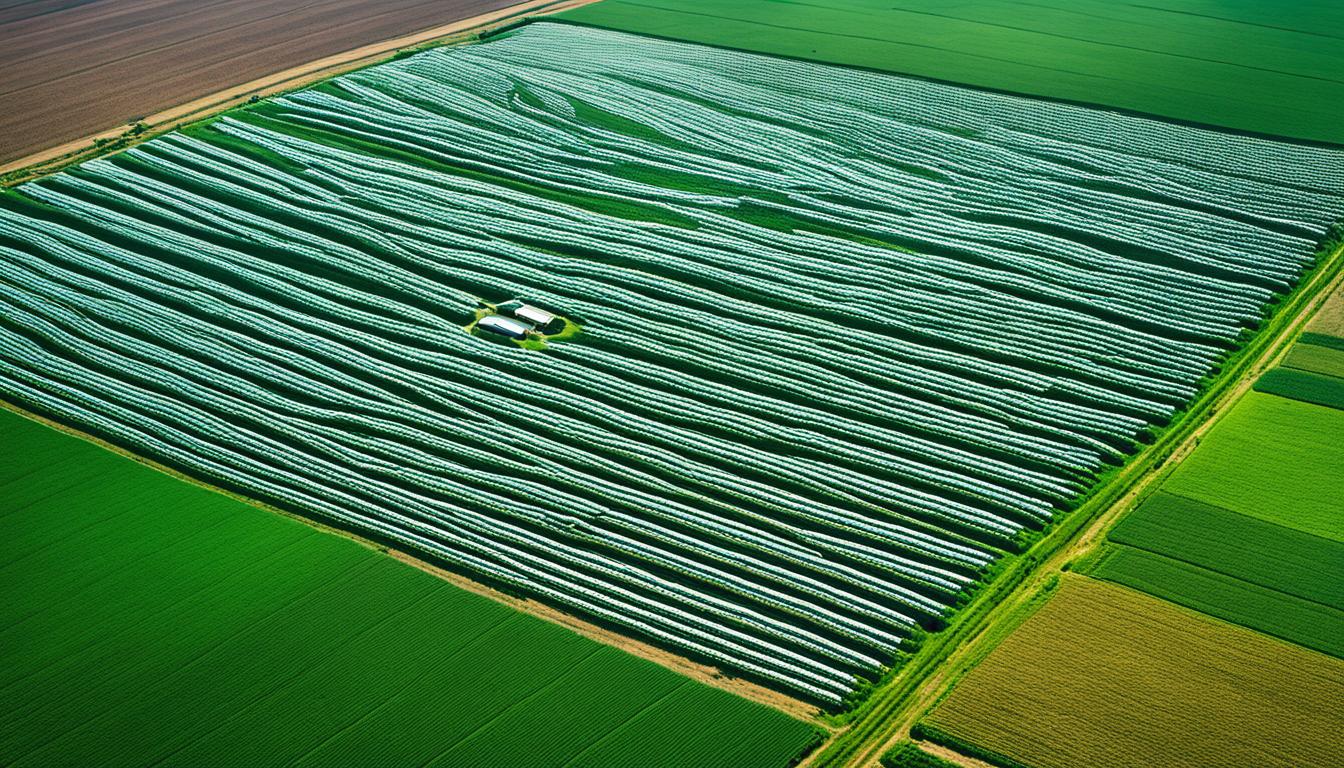
Did you know agriculture only makes up around 3 percent of the global GDP? This small number shows how important it is to push for new ideas in farming and food safety. Luckily, we are entering a new era full of hope, thanks to technology-driven innovations. These new digital tools help make farming more profitable, efficient, and kinder to the environment.
Across the pond, in the United States, people are starting to see the big benefits of going digital in farming. This trend is clear from events like the Center for Digital Agriculture (CDA) conference. Since 2018, this conference has been gathering experts and hundreds of people to talk about using smart technology in fields and designing farms with people in mind.
Smart farming, also called digital farming, is becoming more popular. It means using high-tech tools in agriculture to work better and smarter. For example, Rutherford Farms uses many weather stations, helping them make better plans. And big projects, like Innovations Farms Powered by AgExpert, are showing how lots of land can be managed with modern technology.
But moving from the old ways of farming to the new digital era is a big challenge. It needs mixing powerful computers with knowledge from people who study farming and technology together, like in Yongsheng Chen’s talk at the 2024 CDA conference. The CDA is also working hard to help by offering special degrees in digital agriculture and teaming up with farmers. This teamwork is key to making the change happen.
The digital farming emergence is shaking up agriculture. It mixes old farming know-how with new tech. It brings big changes and challenges. We now need new ways and tools to farm better and greener.
This change is key for food safety and to keep farming sustainable. It gets support from the government. Plus, IoT and AI are becoming part of farming. This is all about making the future of farming secure and eco-friendly.
The digital farming emergence is a huge step forward in farming. The University of Illinois leads in this digital move. Its ACES and Grainger College of Engineering are top in their fields.
They now offer a special degree that combines technology with farming. There’s also a program mixing computer sciences with animal sciences coming. Government and industry help, along with lots of funds, support new research in farming tech.
The Digital Farm Infrastructure gives needed tools for research. This boosts agriculture’s digital change.
From traditional to digital, farming has come a long way. Before, it was all about hard work with basic tools. But now, thanks to tech like IoT and AI, farming is more efficient than ever before.
The University of Illinois offers degrees that prepare people for digital farming. And projects like the Digital Agriculture Data Collaboratory focus on using data better. This helps make smarter farming choices.
Research by the Center for Digital Agriculture looks at farming automation and improving animal and plant health. It’s about making farming better in every way.
When we talk about future digital farming, we see some key changes. These changes are making a big difference in how we grow food. Precision agriculture and the use of IoT are at the heart of this shift.
These solutions use the latest tech to make farms more productive. Right now, only 25 percent of farms in America use smart devices. There’s a big chance for more farms to adopt these. They use GPS, drones, and artificial intelligence to focus on specific parts of fields. This can save water, reduce the use of chemicals, and boost yields. Plus, it cuts down on harm to the environment. For example, drones offer a cheap way to keep an eye on crops and animals from above. This gives farmers quick insights into how things are going.
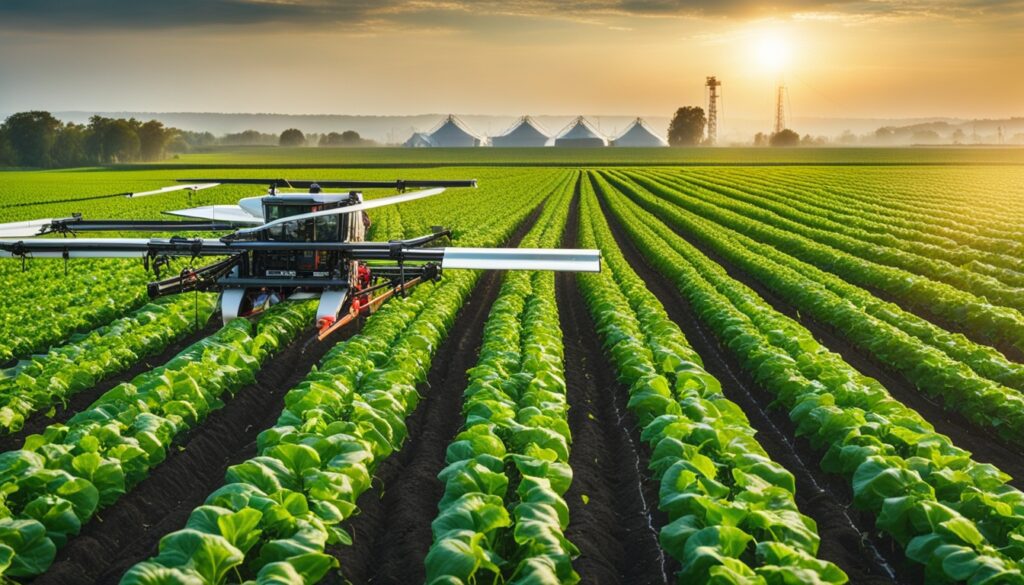
Adding IoT to farming changes how farmers look after their land. It allows for immediate updates on soil, crops, and the weather. With the market for farming tech growing, these tools are key. They help farms work more precisely and sustainably. Devices like connected tractors use GPS and photos to do tasks more efficiently. This means less work for farmers and better harvests.
The advent of IoT and precision farming marks a big move to smarter, more data-driven farming.
These steps show how farming is going digital. Using precision farming and IoT makes agriculture smarter. It helps make farming more profitable while looking after the planet.
| Country | Number of Drones in Agriculture | Market Value 2022 | Expected Market Value 2030 |
|---|---|---|---|
| China | 42,000 | $4.1 billion | $18.22 billion |
| India | – | – | – |
Climate change is challenging farmers worldwide. Rising temperatures, more droughts, and less fertile soil are big problems. The world’s population is growing fast and could reach 2 billion more people by 2050. This means the farming industry has to make more food in the next few decades than in the last 8,000 years.
Places like the United States have already seen corn yield drops of 15-30% from droughts and floods. These weather events are the main cause of crop losses now. So, it’s crucial to adapt farming to deal with climate change. Predicted severe impacts by 2050 include more droughts and big crop losses in parts of the US.
A warmer climate might also mean more pests that harm crops. It’s expected that 50% of wheat and 30% of maize could be lost every year. To combat this, smart agricultural technologies are key. They improve farming methods like irrigation, fertilisation, and pest control. This makes farming more sustainable and helps reduce the costs for farmers.
| Climate Challenge | Effect on Agriculture | Financial Impact (Annual) |
|---|---|---|
| Rising Temperatures | Reduced Crop Yields | $20 Billion (US) |
| Frequent Droughts | Decreased Water Supply | $50 Billion (Losses) |
| Invasive Pests | Increased Crop Destruction | Up to 50% Wheat, 30% Maize |
Food insecurity might affect 80 million more people by 2050 because of climate change. To fight this, we need sustainable farming and digital tools in agriculture. These tools provide insights into the local climate and help plan for future crop yields better.
Modern agriculture has a new hero – data analytics. This tech is changing how farmers manage their land. By using huge amounts of data, they can decide on the best actions for higher output and less impact on the environment.
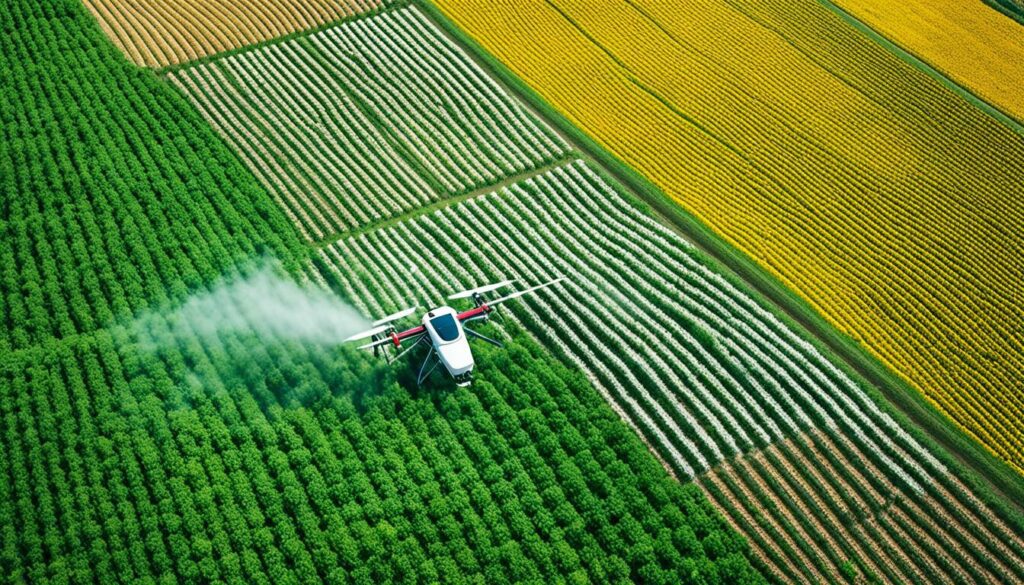
Data-driven farming makes better use of resources. It takes info from satellites, soil checks, and weather forecasts to grow better crops. This means farmers can use water, fertilisers, and pesticides more cleverly, which helps the environment.
Data analytics also helps farmers be kinder to the planet. It shows them how to use resources in greener ways, cutting down on waste and harm to the land.
Predictive farming uses old data to guess what the future holds for crops. This guessing game can help farmers prepare for bug attacks or bad weather. They can act early to avoid large problems and be better prepared.
This isn’t just about taking care of crops. It stretches across the whole farming cycle. From moving goods to guessing what people will want to buy, data analytics makes sure food gets to you in the best way. This helps use less food and makes eating safer for everyone.
| Expert Opinion | Percentage |
|---|---|
| Importance of software-based decision support systems | 58% |
| Significance of sensors in data-driven agriculture | 48% |
| Recognition of digital communication tools | 48% |
| Usage of geographic information systems (GIS) | 46% |
| Utility of geo-locating systems (e.g., GPS) | 40% |
| Importance of spectral reflectance sensing | 36% |
To sum up, data analytics and predicting the future of farming are key to agriculture’s progress. As farming changes, data use will be vital in feeding the world and looking after the planet.
With the world’s population growing fast, we need 70% more food by 2050. Smart farming is key today. It is changing how we farm. These new ways make farm work better, kinder to our planet, and use less.
AI in farming is a big deal. It looks at data, can tell when machines need fixing, and does tasks itself. Think of robotic tractors and harvesters. They farm better and more exact than people, without needing many hands to help. Put AI and robotics together, and farms get smarter. They look after plants better, use water well, and feed crops right. So, we get more food, but we don’t waste as much. The precision farming market is set to hit $16.35 billion by 2028, growing a lot each year.
Blockchain is becoming a very important tool for food safety. Now, nearly 10% of the world feels hungry. Tracking food’s path from farm to plate, it stops lies and makes those in charge more honest. People can trust where food comes from, and those who grow it are fair.
Farming is getting a major upgrade. Thanks to tech like AI, robots, and blockchain, growing food is better for our world and safer. These innovations are making sure farming is efficient, gentle on nature, and open to all.
| Smart Farming Technology | Benefit | Impact |
|---|---|---|
| AI and Robotics | Automated and precise farming | Increased productivity, reduced labour costs |
| Blockchain Technology | Traceability and transparency | Enhanced trust, reduced fraud |
| Indoor Vertical Farming | Water-efficient cultivation | 70% less water usage |
| Laser Scarecrows | Reduced crop damage | 70%-90% decrease in bird population |
Today, it’s more critical than ever to farm sustainably. It’s key to the long-term health of our planet. The National Academy of Sciences states that farming is changing, with more use of digital technology. This move to digital farming is important for the future of agriculture.
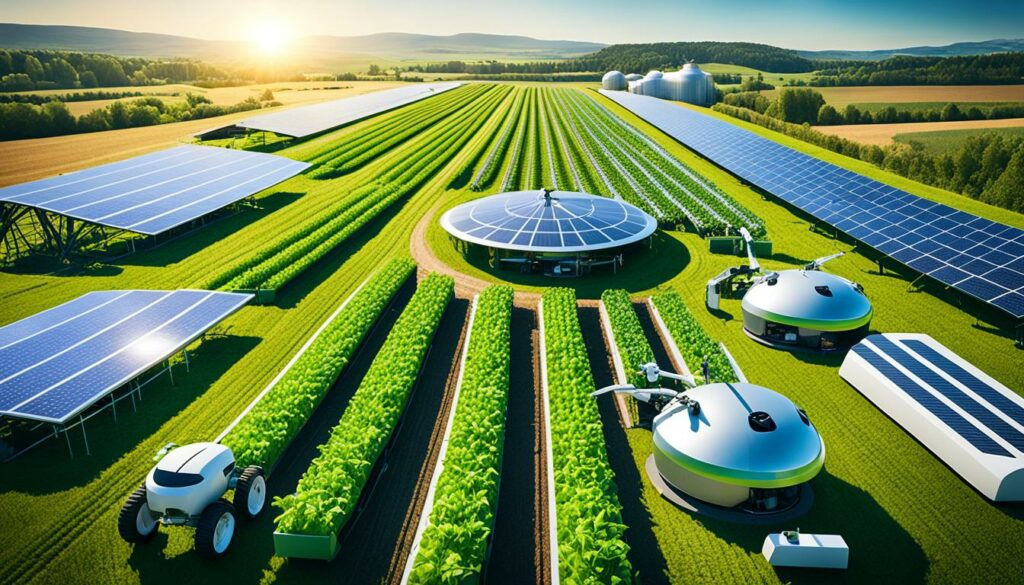
Farmers can now use sensors to keep a close eye on their farms. This means they can make smart, eco-friendly choices. Thanks to wireless tech, they can manage irrigation better. This saves water, chemicals, and electricity.
Drones have become essential in modern farming. They started by spraying chemicals. Now they provide vital info on how crops are doing. This helps farmers grow more food the green way.
Biotechnology is also key. It helps create crops that can handle tough times, like droughts, better. This effort is crucial for farms to keep being productive and eco-friendly as the climate changes.
Smart Farming covers a range of new technologies. These include IoT, AI, and blockchain. Together, they make farming more efficient, safer, and better for the planet.
However, there are issues. Who controls the data and the impact on jobs are big concerns. We need to address these to make sure everyone benefits from digital farming.
In the end, sustainable farming is a must. With new digital tools, we can make green farming the norm. This is vital for the future of agriculture.
Digital farming technologies have a lot of potential. But, they face many barriers to being widely used. The main issues are about money and the lack of the right infrastructure.
Cost and the price of new technology are big concerns for farmers. It’s hard for them to start using new tools because they’re expensive and can be tricky to set up. The U.S. Department of Agriculture has noticed that almost no farmer uses digital tools 100%. This is mainly because of how much they cost and how slow it is to make money back from them. In 2021, farmers globally spent around $18.2 billion on these new technologies. But, they need easier ways to pay for them to really benefit.
The lack of good rural infrastructure is also a major problem. Places far from cities often don’t have good internet or technology. This makes it hard to use digital tools in farming. For modern farming methods to work, farms need better technology and internet. With these in place, smart farming ideas can be put to good use. The digital farming community is working to make tools that are easy to use and share information in the same way. This should help farmers do better with new technology.
Governments and policymakers play a vital role in encouraging the use of high-tech farming tools. They design policies and offer help that lead to more innovative and eco-friendly farming. Governments support the use of technology in farming to make it easier for all farmers to benefit.
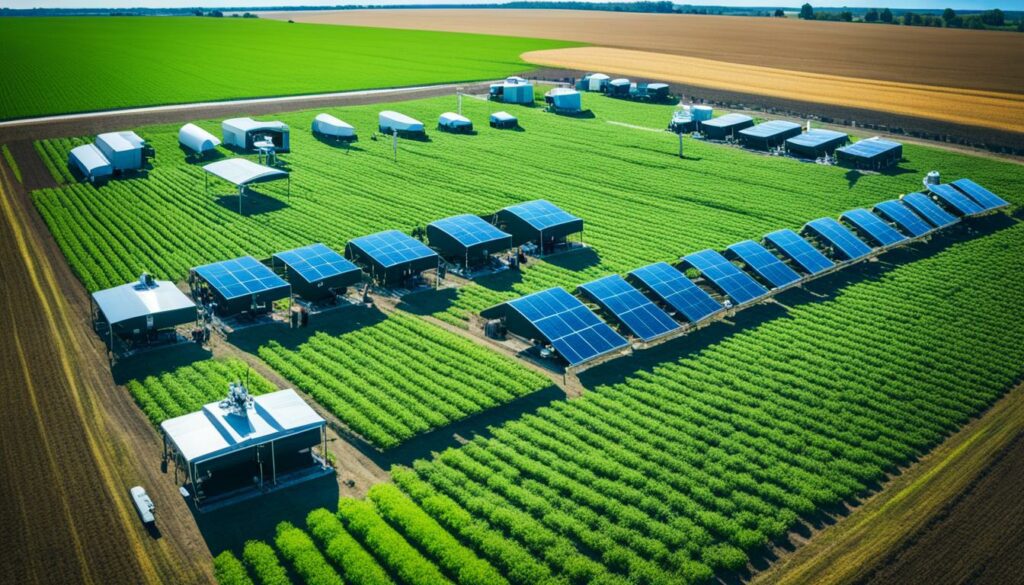
Digital agriculture uses high-tech tools like sensors, drones, and AI to farm more efficiently. These technologies are only helpful when countries have clear digital farming policies in place. Such policies can make farming more productive, help the environment, and create new jobs.
Different approaches to digital farming exist worldwide. The USDA’s plan focuses on farming sustainability while using some chemicals. In contrast, the European Commission wants to use fewer chemicals to save resources. These policies fight food scarcity, protect the environment, and make sure everyone benefits from tech.
The teamwork of public and private groups speeds up the launch of new farming tech. These partnerships make it easier to share technology by working together and sharing skills and resources. Such efforts are encouraged by governments to help the farming and tech sectors grow together.
Public and private groups working together can make data and tech more available. This collaboration boosts farm income and the overall economy. These partnerships are key to digital farming’s main goals: produce food more sustainably, increase productivity, and benefit society and nature.
Governments incorporating digital technologies into their agricultural policies can drive profound on-farm and off-farm impacts, transforming the landscape of modern farming.
Agriculture is quickly changing, moving towards more connected and sustainable ways. Rutherford Farms is leading this change by using advanced farming tech. Since 2014, they’ve used section control, AutoPath, and sensors to watch over their farm. These tools help them work better while looking after the environment.
EMILI’s Innovation Farms Powered by AgExpert is pushing the limits. It’s the biggest in Canada, covering 5,500 acres. This farm is also the first of its kind in Manitoba. It sets aside 100 acres to test new tech, proving that testing on a large scale is the future. Innovations like this show how farming is merging with cutting-edge tech to do amazing things.
The University of Alberta is also making a big impact. They’ve collected almost 3,000 soil samples since 1997. Their work focuses on soil health and the tiny life in the soil, showing a big push for sustainable farming worldwide. Rutherford Farms, for example, is now 30% more efficient with carbon than 20 years ago. This is because they’ve changed how they farm, using fewer chemicals and better farming practices.
“The future of farming hinges on integrating multiple innovative technologies to create an ecosystem that is efficient, environmentally friendly, and highly productive.”
In Europe, big projects prove their dedication to farming tech. Initiatives like ScaleAgData, CrackSense, and AgriDataValue show that Europe is investing heavily in the future of farming. These projects, along with the European Cloud & Edge strategy, aim to support future trends in farming.
Looking forward, tech will keep changing the face of farming. Right now, farms are using more and more advanced tech to be better. They want to grow food in ways that protect our planet. This push for technological innovation aims to make sure there’s enough food in the future.
John Deere set the bar in farming’s digital change. They use high-tech with their machines in their standout John Deere digital strategy. In 2016, they made $26.6 billion across the globe, making them the top farm equipment maker.
In 2012, John Deere started MyJohnDeere to bring everyone together. This platform links devices, users, sellers, and advisors. It lets them look at data to make farms better. This shows how serious they are about smart farming.
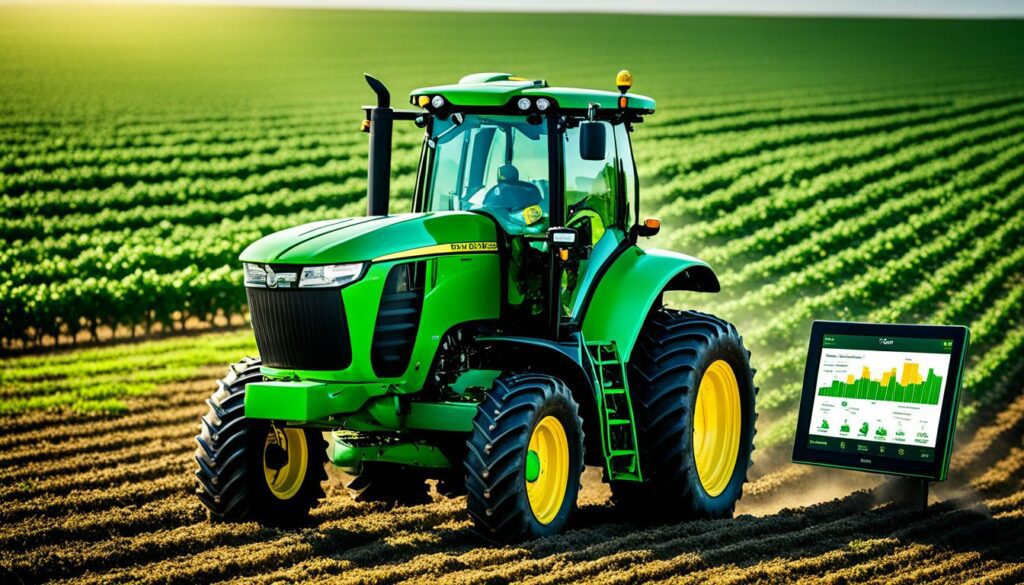
Their apps and technology are key to their move. They help control vehicle fleets, find inefficiencies, and reduce fuel use. In a bold step in 2013, they opened up to others in the field. This includes suppliers, shops, advisors, and software firms. They all work together to improve farming.
John Deere combines software with machines. This is at the heart of their John Deere digital strategy. They offer MyJohnDeere free with their machines. This helps boost machine sales and keeps the competition out. It’s all about their smart future in farming.
John Deere started in tech early to make others in the field work with them. They use big data to make farming better. They also find new ways to make money from all the data they collect.
The aim is clear: to lead in the farming tech market. John Deere’s early and strong move in digital transformation in farming is crucial. They push farming towards a tech-filled and green future.
Their full smart strategy has made John Deere a major in Ag Tech. Many farmers use their apps along with their tools. This helps farmers make better choices. They keep working to make farming more connected and efficient.
Getting rid of gender gaps and making farming tech available to all is hard. But, it’s crucial to make agriculture an equal field for everyone. We need to help women in farming get the same chances and resources to use new farming technologies.
Women who work in farming often find big challenges. They struggle to get land, money, and needed information. For example, in a digital farming project, only 152 out of 500 farmers were women. Many of these women also had little education, making it hard for them to use new technologies well.
Less education often means women are less likely to use digital tools in farming. This, along with not owning tech and lack of skills, makes it tough. We need to work hard to remove these obstacles for women in farming.
Helping more women and young people start or grow their businesses is a great start. Specifically, supporting women in these efforts with loans and joining savings groups works well. For instance, many are investing in small businesses like making peanut butter.
Offering up-to-date farming tools and services also empowers women. For instance, USAID RASS helped 22,300 farmers, over half being women, by improving their farming. Plus, now, with the Maputo Protocol, women have more support in agriculture in places like South Sudan.
Making farming tech open to everyone not only ends gender differences but also boosts farming. By focusing on what women in agriculture need, we can make agriculture fairer and better for all.
The way farming works is changing fast because of digital tools. Making sure farmers and others know how to use these tools is key. This helps everyone get all the good stuff from digital farming.

Creating special training for digital as agriculture is really important. It makes sure farmers and agribusinesses learn how to use high-tech stuff like AI and robotics. With the right skills, farming gets better without using too many resources. It also means we make better food and protect the planet more. A recent report shows how using IoT and data can make farming smarter. This helps in making decisions based on data, which leads to better farming.
Digital farming needs more than just the farmers alone. Tech companies, farm businesses, governments, and others need to work together too. But sometimes, it’s hard to share info and work together because of limited access. Coming together in workshops or other events can change this. For example, a workshop brought together 187 people from different places. It showed how important digital farming is for the world. This kind of teamwork can point out where we need to focus on research to make food and the environment safer.
Digital agriculture is changing farming across the world, particularly in poorer areas. Backed by groups like the U.S. Agency for International Development and the Bill & Melinda Gates Foundation, new reports show the big impact digital tools are having. These tools include precision farming, sensors, and data analysis.
But, for many farmers, the cost is a big worry. To help, some services are making it easier to sell crops, like India’s e-NAM and Kenya’s Twiga. The tools they offer help with money and getting products to market. This means farmers can make more money and work more efficiently using digital supply chain management.
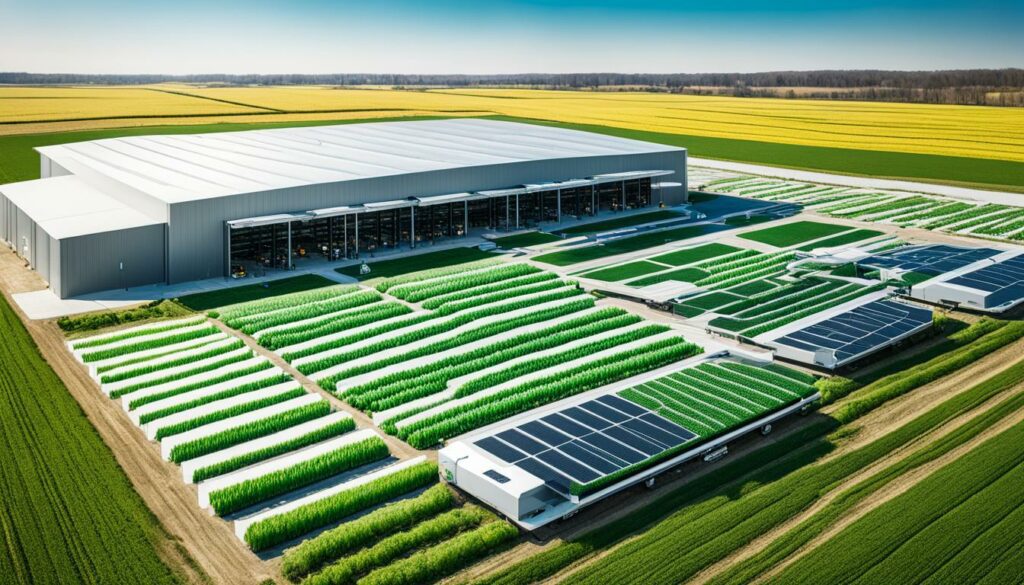
However, not everyone can easily use these new technologies. Some places don’t have good internet, power, or the right tech. Still, new ways of storing and moving goods are already reducing losses. Plus, tests with drones and self-driving vehicles might cut down on wasted food.
Governments need to help break down these barriers. They could offer cheaper loans and improve things like roads. Making supply chains smarter means better farming, less waste, and meeting what people want to buy.
| Country | Platform | Impact |
|---|---|---|
| India | e-NAM | Improved price transparency, eliminated intermediaries |
| Kenya | Twiga | Facilitates supply chain financing, fresh produce logistics |
| Laos | Blockchain in Banana Farming | Enhanced traceability, built consumer trust, eliminated revenue leaks |
Measuring how effective digital farming is very important. It helps modernise and make farming more sustainable. To do this well, we need the right ways to measure the impact. The “State of the Digital Agriculture Sector” report, supported by the U.S. Agency for International Development, DAI, and the Bill & Melinda Gates Foundation, says we need strong methods.
New tech like AI, blockchain, and robots are changing farming. They allow for precise farming with smart sensors and data analysis. But, we don’t yet have good ways to check how much good these new technologies are doing in farming.
To measure the effect of digital farming, we need clear ways. We look at things like more crops, spending less money, and helping the environment. Money matters a lot here, as new tech can be expensive and hard to use for some farmers. So, having easy and trustworthy ways to measure these impacts is crucial.
We must create and use systems to check on digital farming’s real effects. These systems have to deal with problems like bad internet, no proper facilities, and getting people to use the tech. They should also look at how men and women are affected and make sure everyone can be part of digital farming.
| Area of Measurement | Digital Farming Metrics | Challenges Encountered |
|---|---|---|
| Yield Improvement | Increase in crop outputs | High initial costs, technical challenges |
| Cost Reduction | Operational and labour cost savings | Financial viability, access to technology |
| Environmental Impact | Reduction in pesticide use, carbon emissions | Regulatory barriers, climate-smart credibility |
| Social Inclusion | Empowerment of marginalised groups | Gender inequality, social exclusion |
These systems help put digital farming into action fairly. They make sure everyone benefits, making farming better and more sustainable for all.
In the changing world of digital farming, good connections are the key. By 2030, better digital connectivity in farming might raise the world’s economy by $500 billion. This is a big jump for farming, which is a bit slow to catch up.
With more people coming, we’ll need 70% more food by 2050. To meet this, agriculture technology integration is crucial. Better connections will help farms work smarter and more efficiently with new tools like predictive analytics.
It’s important to make sure everyone in the country has good internet. By 2030, 80% of the countryside could have top-notch connections. This helps farmers everywhere join the digital age, which is crucial for their success.
Having strong connections means more than just good internet in the countryside. It means farming can be high-tech, with big benefits like better monitoring and machines that can work alone. This leads to more food grown and lower costs.
Take John Deere, for example. Their work with over 330 million acres proves that connected farming is the future. It brings value and helps the environment through agriculture technology integration.
| Year | Projected Impact | Percentage Improvement |
|---|---|---|
| 2030 | $500 billion added to global GDP | 7 to 9% |
| 2030 | 80% rural areas with advanced connectivity | — (Not Applicable) |
| 2050 | 70% increase in available calories needed | — (Not Applicable) |
Moving forward, the farm industry needs to face some tough issues like costs and how complex these new systems are. Overcoming these barriers will take work from everyone. The goal is to make farming more sustainable and productive with better connections.
The future of farming is exciting because of digital technology. It will make farming better, more eco-friendly, and bring everyone together. This includes using smart tools and analysing a lot of data. But, switching to these new ways isn’t easy. A study in Germany found that at first, people didn’t want to try new tech. However, they changed their minds when they learned it could help the environment, which shows the big role of green education.
People felt differently about new farming technology. Some were interested because it could help everyone, or because it might be good for them. But a lot cared about its impact on nature the most. Although digital tools could make them buy more from big farms, they still prefer small ones. This tells us how important public opinion is, and how it guides both policies and tech use. Big farms, often seen in a bad light, can be harmful to nature. So, it’s key to use new tech while also protecting our environment.
How people see new farming tech is crucial in whether they adopt it. And big parts of their choice are eco worries. The future of digital farming depends on working together and focusing on real gains for everyone in farming. We must listen to what farmers, consumers, and the environment need. By addressing these various concerns, we can truly change farming digitally for the better.
Precision agriculture, IoT, and smart farming are leading trends. They boost farm efficiency and support our environment.
Digital farming has changed how we farm. It’s moved us towards smarter, data-focused methods. Now, we can use IoT, AI, and big data to farm better.
IoT allows farmers to oversee their fields in real time. It collects data on soil, weather, and crops. This helps them make smart choices to improve their yields.
Digital tools are key to using resources better and reducing waste. They also help to protect our planet for the future. It’s all about farming smarter for the long-term.
There are obstacles like cost, finding ways to finance this, and ensuring the right tech’s in place. Tackling these issues needs new funding ideas and better rural tech support. It’s all about finding solutions that work for farmers.
Government backing helps innovation, encourages teamwork, and offers help to adopt new tech. It can improve food security and drive progress in farming technology.
Data analytics makes farming more efficient and productive. It helps farmers avoid risks and plan better. Agriculture becomes an industry that responds effectively to challenges and needs.
AI and robots are changing how we farm by analysing data and working the land. They make operations more efficient and cost-effective. This new tech means farming is more precise and easier to manage.
It’s crucial to make sure everyone has a role in digital farming. Helping all genders and groups access and use tech makes farming better. It also makes our society fairer and more effective in using new tech.
Farmers and others in the industry need to know how to use digital tools well. Training and working together are vital. This boosts the use of new tech and its benefits.
Smart supply chains make sure food gets to where it’s needed with less waste. By using digital tech, supply chains get stronger and more flexible. This supports how farming adapts to changes and grows.
Rural areas often struggle with poor internet and tech access. To fix this, we need to improve rural internet and build more tech-friendly environments. This supports new farming tech in more areas.